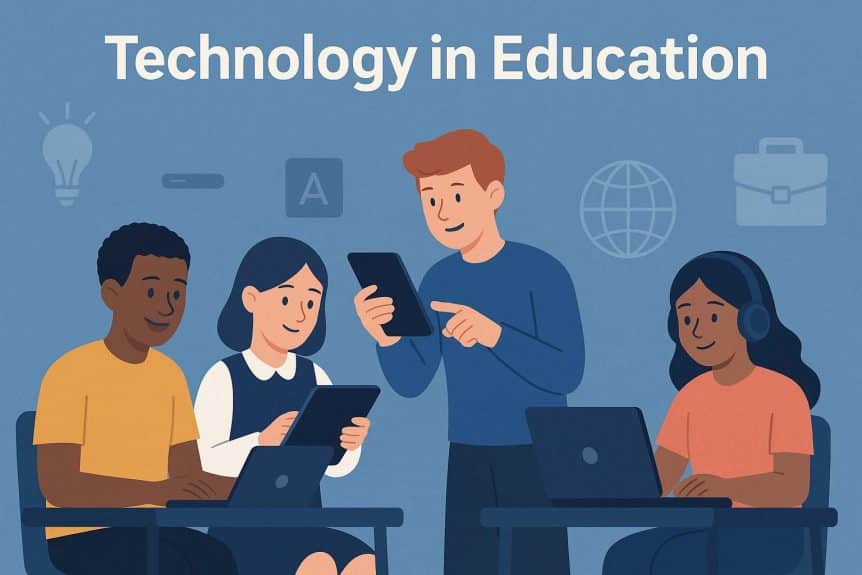Nowadays, students are learning in a new way compared to previous generations. Enter the modern classroom and you will find students designing and running virtual experiments in science, and on the other side, elementary students programming their games. In the meantime, the teacher checks learning progress with AI-powered analytics and understands specific concepts that they may require extra attention on before her lesson the next day. This isn’t from a fiction movie; it’s happening currently in classrooms in the world, where technology in education is reshaping how students learn and teachers teach.
How educational technology has changed learning
Technology and education have been developed beyond the basic computer labs to incorporate digital learning environments. Today’s schools have been introduced to tablets, interactive boards, and cloud-based solutions, which make learning more interesting and easier than ever before.
Students can now access educational content anywhere, collaborate with others globally, and receive instant feedback on their work. Teachers use data analytics to understand exactly where each student needs help and can adjust their teaching methods accordingly. This shift creates dynamic learning spaces where students actively participate in their education rather than passively consuming information.
Schools implementing these advanced systems often require professional IT Support for Education and Schools to maintain optimal performance.
Core technologies shaping modern education
Several key technologies are changing the learning and teaching patterns across educational institutions worldwide. Those are:
1. Artificial intelligence in the classroom
AI-powered learning platforms analyse how students learn best and adapt content to match their individual needs. These systems track progress in real-time, identify areas where students struggle, and suggest personalised learning ways that help every student.
2. Virtual and augmented reality learning
Tech in education now includes VR headsets that take students to ancient civilisations, inside the human body, or to distant planets. AR applications overlay digital information onto textbooks and worksheets, making static content come alive with interactive elements that help students understand complex content more easily.
3. Cloud-based learning platforms
With cloud computing, learners and educators work from any tool and any place. It facilitates smooth collaboration on project work, an automatic backup of assignments, and readily shares resources between classrooms and schools. Such technology in education removes the time and place barriers.
Key benefits of technology in education
Technology brings several advantages in the education sector that improve learning patterns and create more effective teaching environments.
1. Higher student engagement
The interactive content keeps the students engaged and enthusiastic. Digital tools like educational games, multimedia presentations and practical activities help make learning enjoyable and an interactive experience.
2. Personalised learning experiences
Technologies used in learning are flexible to the pace and style of learning with each student. Advanced algorithms track progress and adjust content difficulty, providing additional support for struggling students while creating advanced opportunities for high-achieving learners.
3. Better accessibility
Through digital tools, even students with disabilities get access to education more easily via:
- Text-to-speech software and screen readers
- Visual graphics and customisable interfaces
- Remote learning options for students who can’t attend regular offline classes
4. Real-time assessment and feedback
Having a digital way of assessment also provides students with immediate feedback, to see where they go wrong, while being able to learn quickly and work on these. Teachers get detailed reports on class performance, making it easier to focus on areas that need attention.
5. Global collaboration opportunities
Students can connect with others worldwide, participating in international projects and cultural exchanges. Such exposure expands their mind to meet the global reality.
6. Cost-effective resource management
Online resources and digital textbooks eliminate the printing expenses while staying current with the latest information. It is great because schools and all educational institutions can revise any materials without waiting for a new edition of the textbook.
7. Data-driven decision making
Tech and education integration provides valuable insights into student performance patterns. Teachers can identify learning trends, adjust teaching strategies, and allocate resources based on real-time data analytics.
8. Flexible learning schedules
Learners can learn at their own time and their own pace. This adaptability of technology in education integrates different learning styles and helps students balance academic work with other responsibilities.
The future of digital learning
Education is already developing at a high pace, and provides us with new opportunities and technologies for learning and teaching. Schools are adopting advanced tools that create more interactive and personalised educational experiences.
Tech for education keeps evolving with exciting developments:
- Advanced security systems protect student data and academic records
- Faster internet connections enable high-quality video streaming and real-time collaboration
- Next-generation computing will solve complex problems in math and science education
- Modern education combines in-person and online learning for maximum flexibility
- Schools stay current with beneficial technologies while maintaining focus on learning outcomes.
Conclusion
Technology opens new horizons of interesting, accessible, and meaningful learning experiences. Schools that adopt this technology in education in smart ways, staying focused on high standards of teaching, make students ready to live in our digital world.
The key is all about strategic application, proper training, and good IT support. When technology serves learning goals, it becomes a powerful tool for student success. At Cygnet IT, we support learning institutions to achieve these innovations to create meaningful learning experiences for all students.




